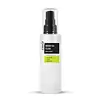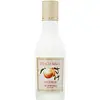What's inside
What's inside
 Key Ingredients
Key Ingredients

 Benefits
Benefits

 Concerns
Concerns

 Ingredients Side-by-side
Ingredients Side-by-side

Water
Skin ConditioningButylene Glycol
HumectantCaprylic/Capric Triglyceride
MaskingHelianthus Annuus Seed Oil
EmollientParaffinum Liquidum
EmollientCetyl Ethylhexanoate
EmollientSodium Hyaluronate
HumectantArachidyl Alcohol
EmollientBehenyl Alcohol
EmollientArachidyl Glucoside
EmulsifyingCyclomethicone
EmollientAloe Barbadensis Leaf Extract
EmollientGlyceryl Stearate
EmollientPEG-100 Stearate
Sorbitan Stearate
EmulsifyingPolysorbate 60
EmulsifyingDiisostearyl Malate
EmollientDimethicone
EmollientHydrogenated Lecithin
EmulsifyingAllantoin
Skin ConditioningTriethanolamine
BufferingXanthan Gum
EmulsifyingTocopheryl Acetate
AntioxidantCamellia Sinensis Leaf Extract
AntimicrobialPanax Ginseng Root Extract
EmollientHoney
HumectantRosa Multiflora Fruit Extract
MaskingGardenia Florida Fruit Extract
Skin ConditioningScutellaria Baicalensis Root Extract
AstringentLigustrum Japonicum Fruit Extract
Skin ConditioningAcanthopanax Senticosus Root Extract
Skin ConditioningPunica Granatum Fruit Extract
AntioxidantCarthamus Tinctorius Flower Extract
Skin ConditioningCarbomer
Emulsion StabilisingDisodium EDTA
Leontopodium Alpinum Extract
Skin ConditioningThymus Vulgaris Extract
PerfumingMalva Sylvestris Flower Extract
Skin ConditioningBambusa Vulgaris Leaf/Stem Extract
HumectantSnail Secretion Filtrate
Skin ConditioningPhenoxyethanol
PreservativeEthylhexylglycerin
Skin ConditioningParfum
MaskingWater, Butylene Glycol, Caprylic/Capric Triglyceride, Helianthus Annuus Seed Oil, Paraffinum Liquidum, Cetyl Ethylhexanoate, Sodium Hyaluronate, Arachidyl Alcohol, Behenyl Alcohol, Arachidyl Glucoside, Cyclomethicone, Aloe Barbadensis Leaf Extract, Glyceryl Stearate, PEG-100 Stearate, Sorbitan Stearate, Polysorbate 60, Diisostearyl Malate, Dimethicone, Hydrogenated Lecithin, Allantoin, Triethanolamine, Xanthan Gum, Tocopheryl Acetate, Camellia Sinensis Leaf Extract, Panax Ginseng Root Extract, Honey, Rosa Multiflora Fruit Extract, Gardenia Florida Fruit Extract, Scutellaria Baicalensis Root Extract, Ligustrum Japonicum Fruit Extract, Acanthopanax Senticosus Root Extract, Punica Granatum Fruit Extract, Carthamus Tinctorius Flower Extract, Carbomer, Disodium EDTA, Leontopodium Alpinum Extract, Thymus Vulgaris Extract, Malva Sylvestris Flower Extract, Bambusa Vulgaris Leaf/Stem Extract, Snail Secretion Filtrate, Phenoxyethanol, Ethylhexylglycerin, Parfum
Water
Skin ConditioningPhenyl Trimethicone
Skin ConditioningAlcohol Denat.
AntimicrobialParaffinum Liquidum
EmollientBis-PEG-18 Methyl Ether Dimethyl Silane
EmollientIsohexadecane
EmollientPrunus Persica Fruit Extract
AbrasiveSorbitan Stearate
EmulsifyingPolyglyceryl-3 Methylglucose Distearate
EmulsifyingRice Ferment Filtrate
Skin ConditioningButylene Glycol
HumectantDimethicone
EmollientEthylhexylglycerin
Skin Conditioning1,2-Hexanediol
Skin ConditioningPropylene Glycol
HumectantCarbomer
Emulsion StabilisingAllantoin
Skin ConditioningTriethanolamine
BufferingSucrose Cocoate
EmulsifyingTocopheryl Acetate
AntioxidantArgania Spinosa Kernel Oil
EmollientHydrogenated Lecithin
EmulsifyingEnantia Chlorantha Bark Extract
Skin ConditioningDisodium EDTA
Sesamum Indicum Seed Oil
EmollientBHT
AntioxidantStearyl Glycyrrhetinate
Skin ConditioningBeta-Sitosterol
Emulsion StabilisingSerenoa Serrulata Fruit Extract
Skin ConditioningPhenoxyethanol
PreservativeTocopherol
AntioxidantGlycyrrhiza Glabra Root Extract
BleachingCentella Asiatica Extract
CleansingGlycine Soja Seed Extract
Skin ConditioningOleanolic Acid
Skin ConditioningChamomilla Recutita Flower Extract
MaskingParfum
MaskingSilica
AbrasiveCI 17200
Cosmetic ColorantCI 19140
Cosmetic ColorantCI 15985
Cosmetic ColorantWater, Phenyl Trimethicone, Alcohol Denat., Paraffinum Liquidum, Bis-PEG-18 Methyl Ether Dimethyl Silane, Isohexadecane, Prunus Persica Fruit Extract, Sorbitan Stearate, Polyglyceryl-3 Methylglucose Distearate, Rice Ferment Filtrate, Butylene Glycol, Dimethicone, Ethylhexylglycerin, 1,2-Hexanediol, Propylene Glycol, Carbomer, Allantoin, Triethanolamine, Sucrose Cocoate, Tocopheryl Acetate, Argania Spinosa Kernel Oil, Hydrogenated Lecithin, Enantia Chlorantha Bark Extract, Disodium EDTA, Sesamum Indicum Seed Oil, BHT, Stearyl Glycyrrhetinate, Beta-Sitosterol, Serenoa Serrulata Fruit Extract, Phenoxyethanol, Tocopherol, Glycyrrhiza Glabra Root Extract, Centella Asiatica Extract, Glycine Soja Seed Extract, Oleanolic Acid, Chamomilla Recutita Flower Extract, Parfum, Silica, CI 17200, CI 19140, CI 15985
Ingredients Explained
These ingredients are found in both products.
Ingredients higher up in an ingredient list are typically present in a larger amount.
Allantoin is a soothing ingredient known for its protective and moisturizingg properties. Because of this, it is often added to products with strong active ingredients.
Studies show higher concentrations of this ingredient can promote wound healing.
Though it can be derived from the comfrey plant, allantoin is produced synthetically for cosmetic products to ensure purity.
Learn more about AllantoinButylene Glycol (or BG) is used within cosmetic products for a few different reasons:
Overall, Butylene Glycol is a safe and well-rounded ingredient that works well with other ingredients.
Though this ingredient works well with most skin types, some people with sensitive skin may experience a reaction such as allergic rashes, closed comedones, or itchiness.
Learn more about Butylene GlycolCarbomer is a polymer of acrylic acid. Its main role is to create a gel consistency.
A high amount of carbomer can cause pilling or balling up of products. Don't worry, most products contain 1% or less of carbomer.
Dimethicone is a type of synthetic silicone created from natural materials such as quartz.
What it does:
Dimethicone comes in different viscosities:
Depending on the viscosity, dimethicone has different properties.
Ingredients lists don't always show which type is used, so we recommend reaching out to the brand if you have questions about the viscosity.
This ingredient is unlikely to cause irritation because it does not get absorbed into skin. However, people with silicone allergies should be careful about using this ingredient.
Note: Dimethicone may contribute to pilling. This is because it is not oil or water soluble, so pilling may occur when layered with products. When mixed with heavy oils in a formula, the outcome is also quite greasy.
Learn more about DimethiconeDisodium EDTA plays a role in making products more stable by aiding other preservatives.
It is a chelating agent, meaning it neutralizes metal ions that may be found in a product.
Disodium EDTA is a salt of edetic acid and is found to be safe in cosmetic ingredients.
Learn more about Disodium EDTAEthylhexylglycerin (we can't pronounce this either) is commonly used as a preservative and skin softener. It is derived from glyceryl.
You might see Ethylhexylglycerin often paired with other preservatives such as phenoxyethanol. Ethylhexylglycerin has been found to increase the effectiveness of these other preservatives.
Hydrogenated Lecithin is created from the hydrogenation of lecithin (a group of phospholipids). Hydrogenation is a chemical reaction between hydrogen and another element.
This ingredient is an emollient and emulsifier. As an emollient, it helps soften skin by trapping moisture within. As an emulsifier, it prevents oil and water ingredients from separating.
Paraffinum Liquidum is also known as liquid paraffin. It is a type of highly refined mineral oil.
Like other oils, Paraffinum Liquidum has emollient properties. Emollients help soothe and soften the skin. By creating a barrier to trap moisture within, emollients help keep your skin hydrated.
Paraffinum Liquidum does not irritate the skin and is non-comedogenic.
Learn more about Paraffinum LiquidumParfum is a catch-all term for an ingredient or more that is used to give a scent to products.
Also called "fragrance", this ingredient can be a blend of hundreds of chemicals or plant oils. This means every product with "fragrance" or "parfum" in the ingredients list is a different mixture.
For instance, Habanolide is a proprietary trade name for a specific aroma chemical. When used as a fragrance ingredient in cosmetics, most aroma chemicals fall under the broad labeling category of “FRAGRANCE” or “PARFUM” according to EU and US regulations.
The term 'parfum' or 'fragrance' is not regulated in many countries. In many cases, it is up to the brand to define this term.
For instance, many brands choose to label themselves as "fragrance-free" because they are not using synthetic fragrances. However, their products may still contain ingredients such as essential oils that are considered a fragrance by INCI standards.
One example is Calendula flower extract. Calendula is an essential oil that still imparts a scent or 'fragrance'.
Depending on the blend, the ingredients in the mixture can cause allergies and sensitivities on the skin. Some ingredients that are known EU allergens include linalool and citronellol.
Parfum can also be used to mask or cover an unpleasant scent.
The bottom line is: not all fragrances/parfum/ingredients are created equally. If you are worried about fragrances, we recommend taking a closer look at an ingredient. And of course, we always recommend speaking with a professional.
Learn more about ParfumPhenoxyethanol is a preservative that has germicide, antimicrobial, and aromatic properties. Studies show that phenoxyethanol can prevent microbial growth. By itself, it has a scent that is similar to that of a rose.
It's often used in formulations along with Caprylyl Glycol to preserve the shelf life of products.
Sorbitan Stearate comes from sorbitol and stearic acid. Sorbitol is a type of sugar and stearic acid is a fatty acid.
It is used as an emulsifier and helps ingredients stay together by creating water-in-oil emulsions.
This ingredient may not be Malassezia folliculitis, or fungal-acne safe.
Tocopheryl Acetate is AKA Vitamin E. It is an antioxidant and protects your skin from free radicals. Free radicals damage the skin by breaking down collagen.
One study found using Tocopheryl Acetate with Vitamin C decreased the number of sunburned cells.
Tocopheryl Acetate is commonly found in both skincare and dietary supplements.
Learn more about Tocopheryl AcetateTriethanolamine is an emulsifier and pH adjuster. It is created using ethylene oxide and ammonia. This gives Triethanolamine a nitrogen core and a similar scent to ammonia.
As an emulsifier, it prevents ingredients from separating and enhances texture by adding volume to a product.
PH adjusters are common in cosmetic products. The pH of a product can affect the effectiveness of other ingredients. A product with a high pH may also irritate the skin.
Learn more about TriethanolamineWater. It's the most common cosmetic ingredient of all. You'll usually see it at the top of ingredient lists, meaning that it makes up the largest part of the product.
So why is it so popular? Water most often acts as a solvent - this means that it helps dissolve other ingredients into the formulation.
You'll also recognize water as that liquid we all need to stay alive. If you see this, drink a glass of water. Stay hydrated!
Learn more about Water